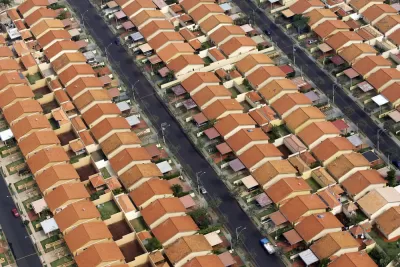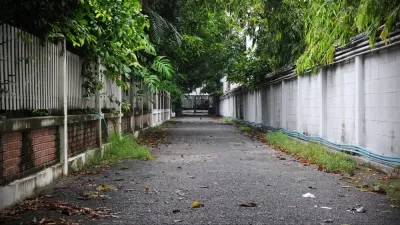It's not a popular viewpoint, but what if suburbs end up being more critical to a sustainable and efficient future than dense urban areas?

Randy Rieland reports on a proposition that might come as a shock, or even an affront, to some who call themselves urbanists: the future of the built environment could still be suburban.
Rieland relies on the ideas and research of Alan Berger, a professor of landscape architecture and urban design at MIT, who recently convened the "Future of Suburbia" conference. Among the speakers and futurists at the event, a much more environmentally friendly portrait of the suburbs emerged:
Their model of a future metropolitan area of 3 million people looks very different from what we’ve come to know. Rather than have neighborhoods continuously spreading outward from a downtown core, it presents a handful of dense clusters amid what Berger describes as a “big sea of suburban development that’s much more horizontal than vertical." It would, he says, function as a “kind of holistic sustainable machine.”
One key concept of Berger's argument: that U.N.'s 2014 "World Urbanization Prospects" report built a misconception that the majority of the world's population now lives in urban areas (i.e., not the suburbs). In fact, says Berger, most of those people are moving to suburbs. "Certainly, the world’s urbanizing, but it’s urbanizing in a much different way than cities," says Berger in a direct quote. "It’s urbanizing horizontally."
FULL STORY: Suburbia Gets No Respect, But It Could Become a Very Different Place

Alabama: Trump Terminates Settlements for Black Communities Harmed By Raw Sewage
Trump deemed the landmark civil rights agreement “illegal DEI and environmental justice policy.”

Study: Maui’s Plan to Convert Vacation Rentals to Long-Term Housing Could Cause Nearly $1 Billion Economic Loss
The plan would reduce visitor accommodation by 25% resulting in 1,900 jobs lost.

Planetizen Federal Action Tracker
A weekly monitor of how Trump’s orders and actions are impacting planners and planning in America.

Baltimore Ordered to Improve Sidewalk Accessibility
The city is one of many to face lawsuits for failing to comply with the Americans with Disabilities Act.

This Toronto Suburb Has More Bus Riders Than Columbus, Ohio
Brampton, Ontario used gradual improvements in service to prove that if you build it, they will ride.

Paris Bike Boom Leads to Steep Drop in Air Pollution
The French city’s air quality has improved dramatically in the past 20 years, coinciding with a growth in cycling.
Urban Design for Planners 1: Software Tools
This six-course series explores essential urban design concepts using open source software and equips planners with the tools they need to participate fully in the urban design process.
Planning for Universal Design
Learn the tools for implementing Universal Design in planning regulations.
Smith Gee Studio
Alamo Area Metropolitan Planning Organization
City of Santa Clarita
Institute for Housing and Urban Development Studies (IHS)
City of Grandview
Harvard GSD Executive Education
Toledo-Lucas County Plan Commissions
Salt Lake City
NYU Wagner Graduate School of Public Service




























